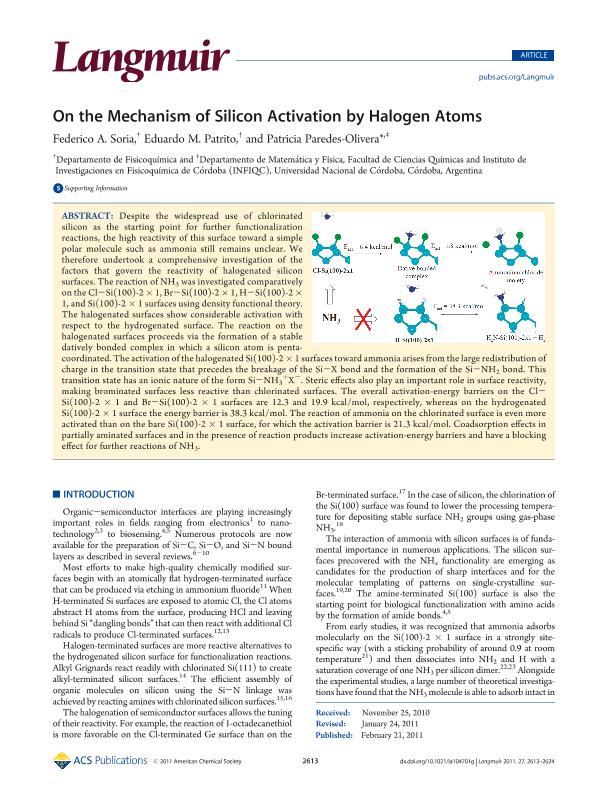Artículo
On the mechanism of silicon activation by halogen atoms
Fecha de publicación:
03/2011
Editorial:
American Chemical Society
Revista:
Langmuir
ISSN:
0743-7463
Idioma:
Inglés
Tipo de recurso:
Artículo publicado
Clasificación temática:
Resumen
Despite the widespread use of chlorinated silicon as the starting point for further functionalization reactions, the high reactivity of this surface toward a simple polar molecule such as ammonia still remains unclear. We therefore undertook a comprehensive investigation of the factors that govern the reactivity of halogenated silicon surfaces. The reaction of NH3 was investigated comparatively on the Cl-Si(100)-2 × 1, Br-Si(100)-2 × 1, H-Si(100)-2 × 1, and Si(100)-2 × 1 surfaces using density functional theory. The halogenated surfaces show considerable activation with respect to the hydrogenated surface. The reaction on the halogenated surfaces proceeds via the formation of a stable datively bonded complex in which a silicon atom is pentacoordinated. The activation of the halogenated Si(100)-2 × 1 surfaces toward ammonia arises from the large redistribution of charge in the transition state that precedes the breakage of the Si-X bond and the formation of the Si-NH2 bond. This transition state has an ionic nature of the form Si-NH3 +X-. Steric effects also play an important role in surface reactivity, making brominated surfaces less reactive than chlorinated surfaces. The overall activation-energy barriers on the Cl-Si(100)-2 × 1 and Br-Si(100)-2 × 1 surfaces are 12.3 and 19.9 kcal/mol, respectively, whereas on the hydrogenated Si(100)-2 × 1 surface the energy barrier is 38.3 kcal/mol. The reaction of ammonia on the chlorinated surface is even more activated than on the bare Si(100)-2 × 1 surface, for which the activation barrier is 21.3 kcal/mol. Coadsorption effects in partially aminated surfaces and in the presence of reaction products increase activation-energy barriers and have a blocking effect for further reactions of NH3. © 2011 American Chemical Society.
Palabras clave:
Superficies
,
Reacciones Superficiales
,
Si(100)
,
Dft
Archivos asociados
Licencia
Identificadores
Colecciones
Articulos(INFIQC)
Articulos de INST.DE INVESTIGACIONES EN FISICO- QUIMICA DE CORDOBA
Articulos de INST.DE INVESTIGACIONES EN FISICO- QUIMICA DE CORDOBA
Citación
Soria, Federico Ariel; Patrito, Eduardo Martin; Paredes Olivera, Patricia; On the mechanism of silicon activation by halogen atoms; American Chemical Society; Langmuir; 27; 6; 3-2011; 2613-2624
Compartir
Altmétricas




